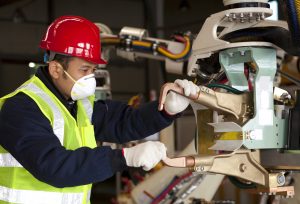If your facility is planning to reopen soon, taking proper safety measures is critical to reduce the risk of exposing your staff to COVID-19. As you prepare your return to work policies, it’s important to remember that the success of your safety initiatives depends largely on the cooperation of your employees. That’s why training and communication are crucial to infection prevention in your workplace.
As your staff members begin to return to your facility, take the time to train them on proper procedures to maintain a safe work environment. Your training should cover the following:
- The symptoms and signs of COVID-19
- Protocols for the use and disposal of protective clothing and personal protective equipment (PPE)
- Etiquette for coughing and sneezing
- Proper hand washing and hygiene practices
- Facility design changes in place to encourage social distancing
- Workplace surface cleaning and disinfection
- Procedures for reporting health and safety concerns
- Company sick leave policy
- Contact tracing plan and return to work clearance process
- Resources for additional information and support
In addition to facilitating employee training, clearly communicate safety protocols and procedures to your workers via emails and conference calls to properly prepare them to return to your facility. This is a stressful time for everyone, so your staff members will likely have questions and concerns that you will need to address. Providing the necessary resources and clear communication are key to successfully implementing your organization’s safety strategy.
Your managers and supervisors may need additional training to help encourage compliance with safety protocols among staff and recognize and respond to any issues that may arise.
As your employees return to the workplace, having a team that specializes in infection prevention services can ensure you make a safe transition. At Aarcher Consulting, we provide return to work plans, infection risk assessments, and pandemic preparedness and response plans. We help you protect your staff and customers, support continuity of operations, demonstrate proactive infection prevention, and improve employee security and morale. Learn more about our Infection Prevention Services.
Resource:
COVID-19: Keep Your Workplace Safe and Healthy During the Pandemic, Guy Burdick, EHS Daily Advisor.
 As states begin to open back up amid the global coronavirus (COVID-19) pandemic, many organizations are starting to plan to return to the workplace. Each employer is ultimately responsible for workplace safety. Assessment of risk, careful planning, and smart communication during this transition will limit further disruptions to your operation. Our infection control specialists have organized some tips for preparing to return to the workplace:
As states begin to open back up amid the global coronavirus (COVID-19) pandemic, many organizations are starting to plan to return to the workplace. Each employer is ultimately responsible for workplace safety. Assessment of risk, careful planning, and smart communication during this transition will limit further disruptions to your operation. Our infection control specialists have organized some tips for preparing to return to the workplace: